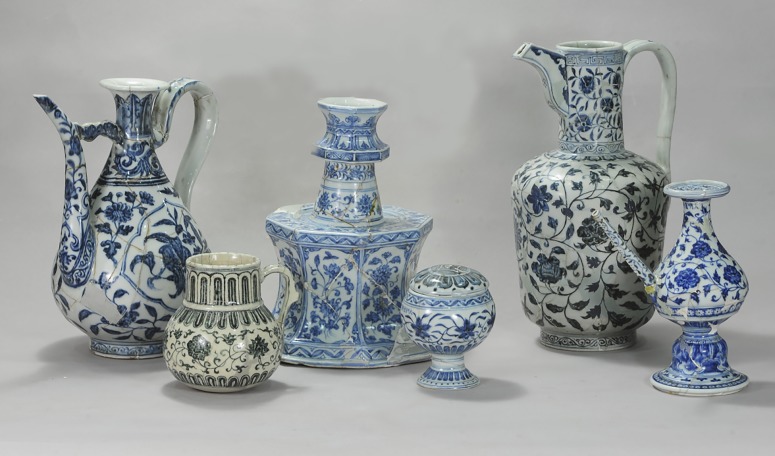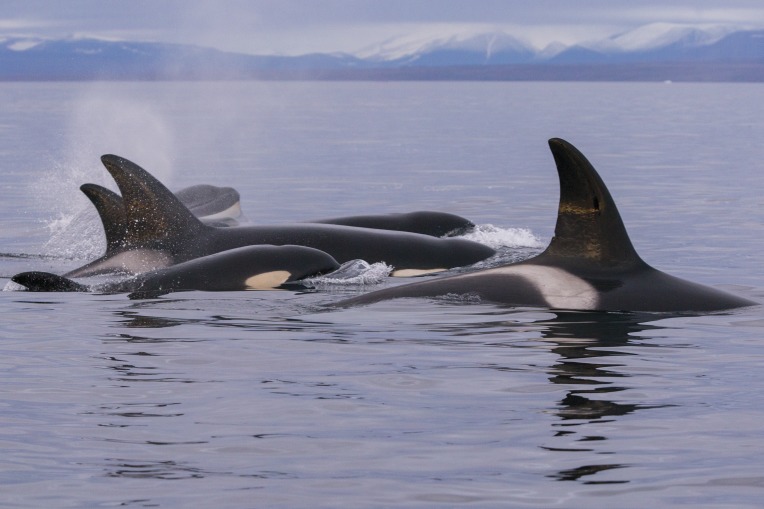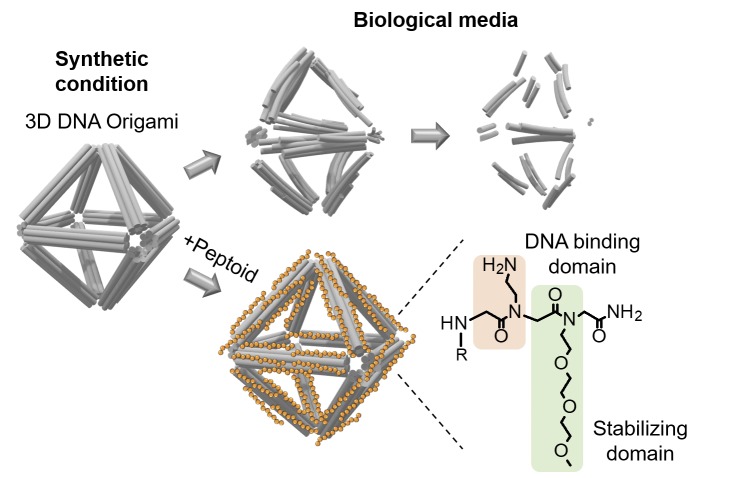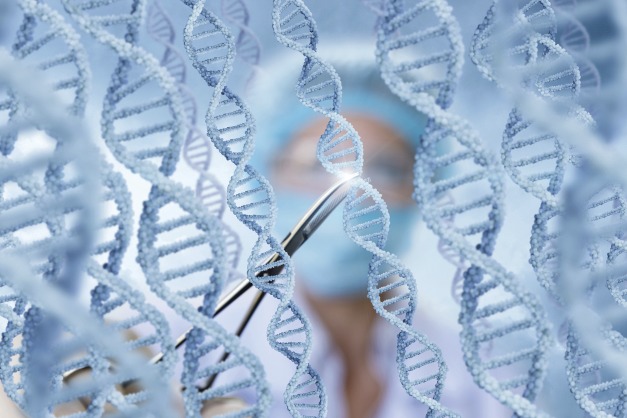Signs of international trade in Chinese porcelain
Xuande blue-and-white porcelain excavated in Jingdezhen, China. Image courtesy of the Jingdezhen Institute of Ceramic Archaeology.
Blue-and-white porcelain made in Jingdezhen, China, during the Yuan and Ming dynasties is associated with imported cobalt pigment. However, it is unclear whether a pigment color imported from the Middle East known as Sumali blue was used throughout the Xuande Period of the Ming dynasty, or if it was superseded by domestic asbolane ores. Pigment during and after 1426 CE exhibits high levels of manganese, similar to domestic ores, whereas imported pigment does not contain manganese. Xiaochenyang Jiang, Yanjun Weng, et al. (pp. 6446–6452) used electron microscopy to analyze blue-and-white porcelain sherds from the Xuande reign and compared them with those from the Yuan and Qing dynasties. The authors detected two types of residual pigment particles in the Xuande sherds that differed in chemical composition, distribution behavior, and morphology. This finding indicates a mixture of domestic and imported pigment in Xuande sherds that was not present in Yuan or Qing dynasty sherds. Blue pigment may have been consistently imported throughout the Xuande period, and an international trading network was established by the 15th century, according to the authors. — M.S.
Stone-Age social networks
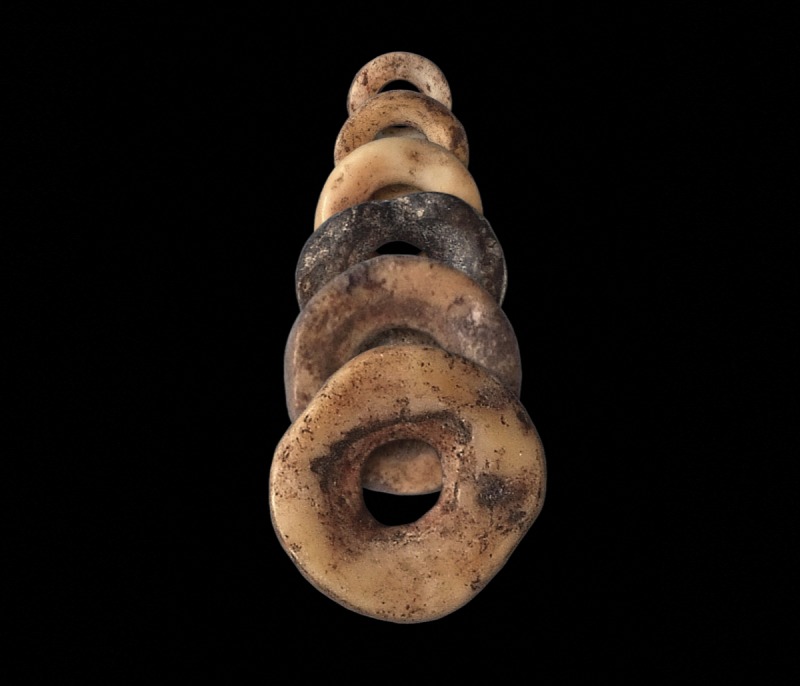
Middle and Later Stone Age beads of ostrich eggshell from highland Lesotho, southern Africa. Image courtesy of Yuchao Zhao and the University of Michigan Museum of Anthropological Archaeology/John Klausmeyer.
Early systems of reciprocal gifting of small, portable items served to cement relationships among hunter-gatherer groups, providing extended networks in times of need. However, the extent and age of such systems in Africa are unclear. Brian Stewart et al. (pp. 6453–6462) analyzed eggshell beads, spanning a 33,000-year period, from two locations in the highlands of Lesotho in southern Africa. The work revealed that by the late Middle Stone Age, relationships among hunter-gather groups in southern Africa existed across hundreds of kilometers. Strontium isotope levels in an ostrich eggshell reflect the amount of strontium in the bird’s breeding territory, and preliminary mapping of the surrounding area’s strontium concentrations showed that the amount of bioavailable strontium increases with distance from the highlands, and that excavated beads originated from lower rock formations. Based on interpretation of historical ostrich range, the authors deduced that all of the sampled beads originated more than 100 km away, with some coming from farther than 300 km. According to the authors, the size of the network implied by the distances, which covered eight different bioregions, would have provided groups with access to high ecological diversity and offered a social strategy to buffer against times of scarcity. — T.H.D.
How killer whales influence bowhead whale behavior
A group of killer whales in Eclipse Sound, northern Baffin Island, Canada. Image courtesy of Maha Ghazal (photographer).
Predator intimidation prompts behavioral changes in prey. However, such changes may harm prey, for example, through lost foraging and mating opportunities. To uncover behavioral responses of prey to predation risk in large marine mammals, Cory Matthews, Greg Breed, et al. (pp. 6590–6598) examined how habitat selection and behavior of bowhead whales changed in response to predation threats from killer whales. Using satellite telemetry, the authors tracked eight bowhead whales and three killer whales in the Canadian Arctic between June and October 2013, including a 3-week period when both species were present in a large, partially ice-covered gulf. Under no threat of predation, bowhead whales preferred ice-free areas in open water. However, when killer whales were present, bowhead whales exhibited reduced activity and moved into areas with dense sea ice and shallow water near shorelines. Bowheads exhibited slow, meandering movements when in open water and fast, directed swimming when close to shorelines; the behavior was reversed when killer whales were present. The findings suggest that predator avoidance in bowhead whales may occur at the expense of foraging in phytoplankton-rich open water, according to the authors. — M.S.
Protecting DNA origami with peptoid coatings
A peptoid coating with a specific molecular design protects 3D DNA origami under physiological conditions, whereas the origami construct falls apart when unprotected.
DNA origami involves using synthetic oligonucleotides to fold a long DNA chain into predetermined 2D or 3D structures. Three-dimensional DNA nanostructures could be used for drug delivery and biosensing. However, DNA origami constructs have poor structural integrity in physiological fluids due to low magnesium ion concentrations and the presence of DNA-degrading enzymes. Shih-Ting Wang et al. (pp. 6339–6348) examined the ability of molecules called peptoids to stabilize an octahedral DNA origami construct (OC) under physiological conditions. The peptoids contained varying combinations of positively charged motifs that facilitate binding to the negatively charged DNA and hydrophilic polyether chains that cover the DNA surface and provide favorable interactions with water. The authors also demonstrated that OCs retained their structure at physiological magnesium concentrations in the presence of certain peptoid architectures, but fell apart in the absence of peptoids. Peptoids also protected the OCs against degradation by enzymes. When OCs were loaded with the anticancer drug doxorubicin, peptoids modulated the rate of drug release. The authors also attached various functional moieties, such as fluorescent dyes and antibodies, to the peptoids, allowing peptoid-coated OCs to be imaged or targeted to specific cells. The results suggest that peptoid coatings could facilitate biomedical applications for DNA origami constructs, according to the authors. — B.D.
Vulnerable robots foster teamwork
Robot behavior can influence interactions between humans and robots, but how robots affect interactions among humans is unclear. Margaret Traeger et al. (pp. 6370–6375) conducted an experiment in which groups of three humans and one robot participated in a collaborative game. A total of 153 human participants were assigned to three conditions characterized by different types of robot behavior. At the end of each round, the robot remained silent, uttered neutral task-related facts, or made a vulnerable statement, such as telling a joke or personal story or acknowledging mistakes. People who heard vulnerable statements spent approximately twice as much time talking to one another, and later reported that their teams were more positive, compared with people in groups in which the robot remained silent or made neutral statements. In addition, conversation among humans increased more over time and was more equally distributed in the vulnerable condition. Taken together, the findings suggest that robots can influence communication among humans, going beyond robot–human interactions. According to the authors, the results could inform the design of artificial agents that promote social engagement, balanced participation, and positive experiences of humans working in teams. — J.W.
Anti-CRISPR proteins expand genome editing toolkit
Anti-CRISPR proteins can help control genome editing. Image courtesy of iStock/Natali_Mis.
Anti-CRISPR proteins (Acrs), which are derived from bacteriophages and encoded in some bacterial genomes, can be used to block or fine-tune therapeutically relevant CRISPR-Cas9–mediated genome editing. Previous efforts have uncovered Acrs against the most commonly used genome editing enzyme Streptococcus pyogenes Cas9 (SpyCas9). Kyle Watters, Haridha Shivram, et al. (pp. 6531–6539) attempted to uncover Acrs against Staphylococcus aureus Cas9 (SauCas9), a genome editor that is smaller and thus easier to deliver into human cells than SpyCas9. Using bioinformatics strategies to identify self-targeting CRISPR-containing genomes and Acr-associated genetic sequences, the authors uncovered three groups of proteins—AcrIIA13, AcrIIA14, and AcrIIA15—that potently block SauCas9 through different mechanisms, such as blocking the genome editor’s functional assembly or its ability to bind double-stranded DNA prior to cleavage. Of the three groups of Acrs, AcrIIA13 was the most potent at blocking SauCas9 activity in human cells in vitro; the inhibitor had no effect on SpyCas9. The protein sequences of the three Acrs carry divergent C-termini that were found to be crucial to their ability to block SauCas9-mediated DNA cleavage. According to the authors, the findings expand the genetic toolkit for precisely controlled genome editing and demonstrate the usefulness of the bioinformatics approach in identifying novel Acrs. — P.N.
Laminarin in marine carbon cycle
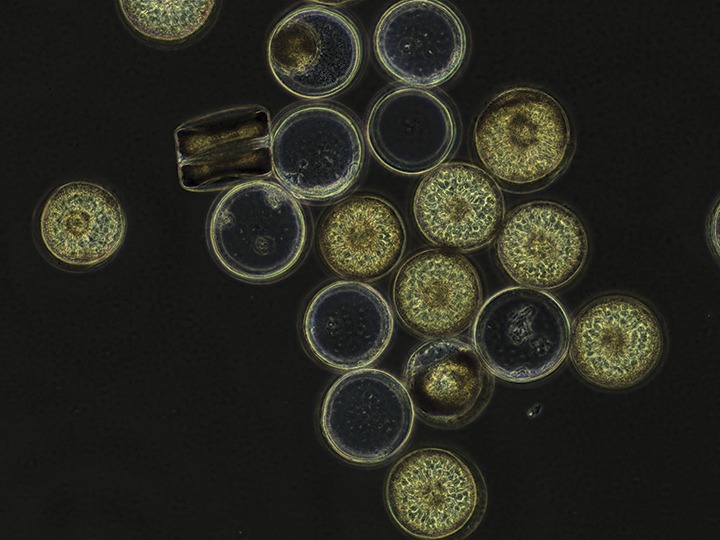
Coscinodiscus wailesii, a diatom species with a high laminarin content. Image courtesy of Craig Robb (University of British Columbia, Vancouver, Canada).
In the sunlit surface layer of the ocean, photosynthetic microalgae such as diatoms convert as much carbon dioxide into biomass as Earth’s tropical forests. Like land plants, diatoms sequester carbon dioxide into polymeric carbohydrates, but the process has proven difficult to quantify on a global oceanic scale. Stefan Becker et al. (pp. 6599–6607) report a recently developed biocatalytic assay to dissect photosynthetic microalgae and to measure concentrations of the polysaccharide laminarin, an energy metabolite for microalgae, including diatoms. Based on microalgae obtained from the Arctic, Atlantic, and Pacific oceans and the North Sea, the authors estimated that 26 ± 17% of the carbon in this biomass is composed of laminarin, suggesting that photosynthesis in the surface ocean produces 12 ± 8 gigatons of algal carbon in the form of laminarin annually. Furthermore, laminarin comprises as much as 50% of the organic carbon in sinking diatom-containing particles, showing that the metabolic pathway supports carbon transfer from surface waters to the deep ocean. As microalgae represent an important base of the marine food web, the findings illustrate laminarin’s key role in global ocean ecology, according to the authors. — T.J.



